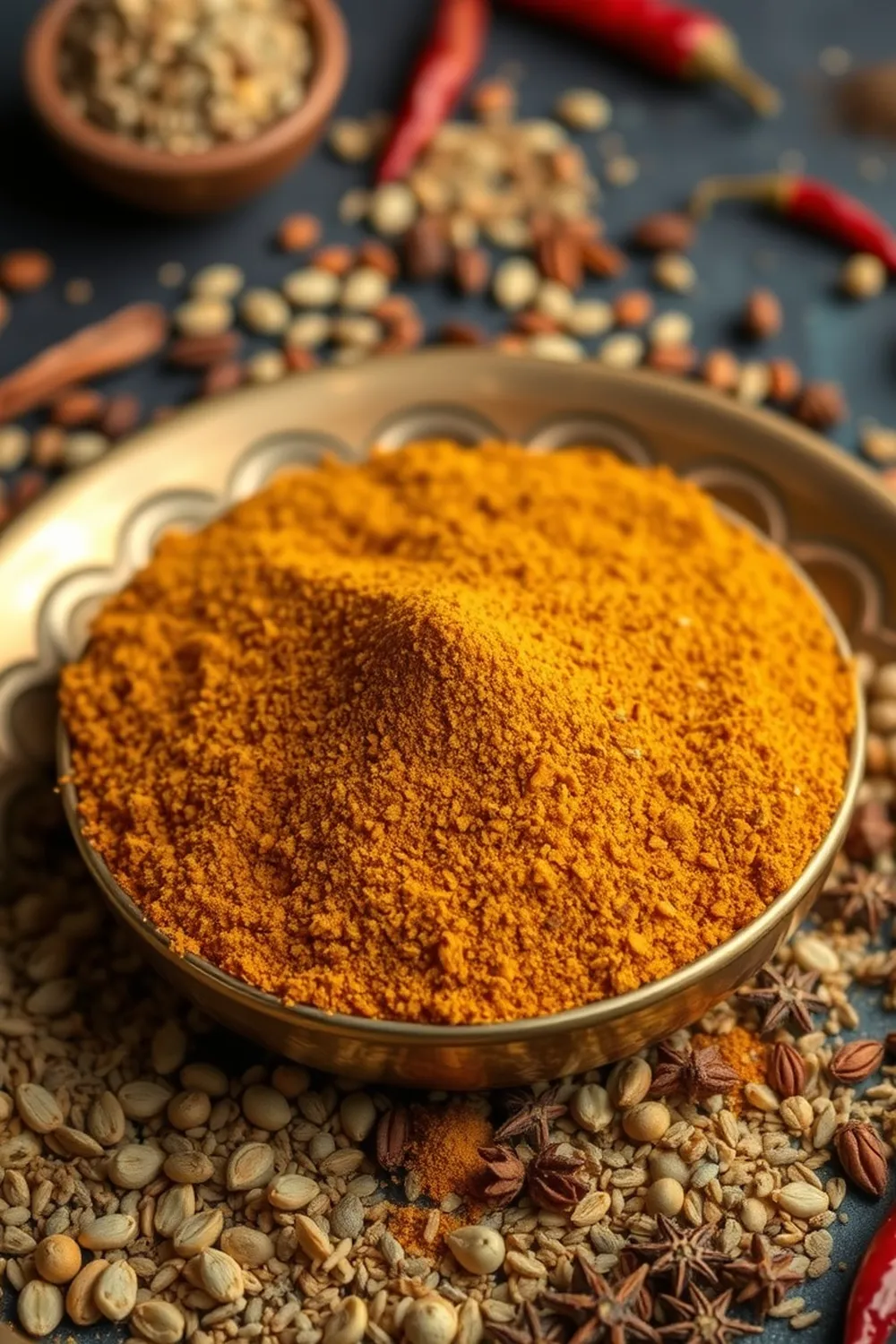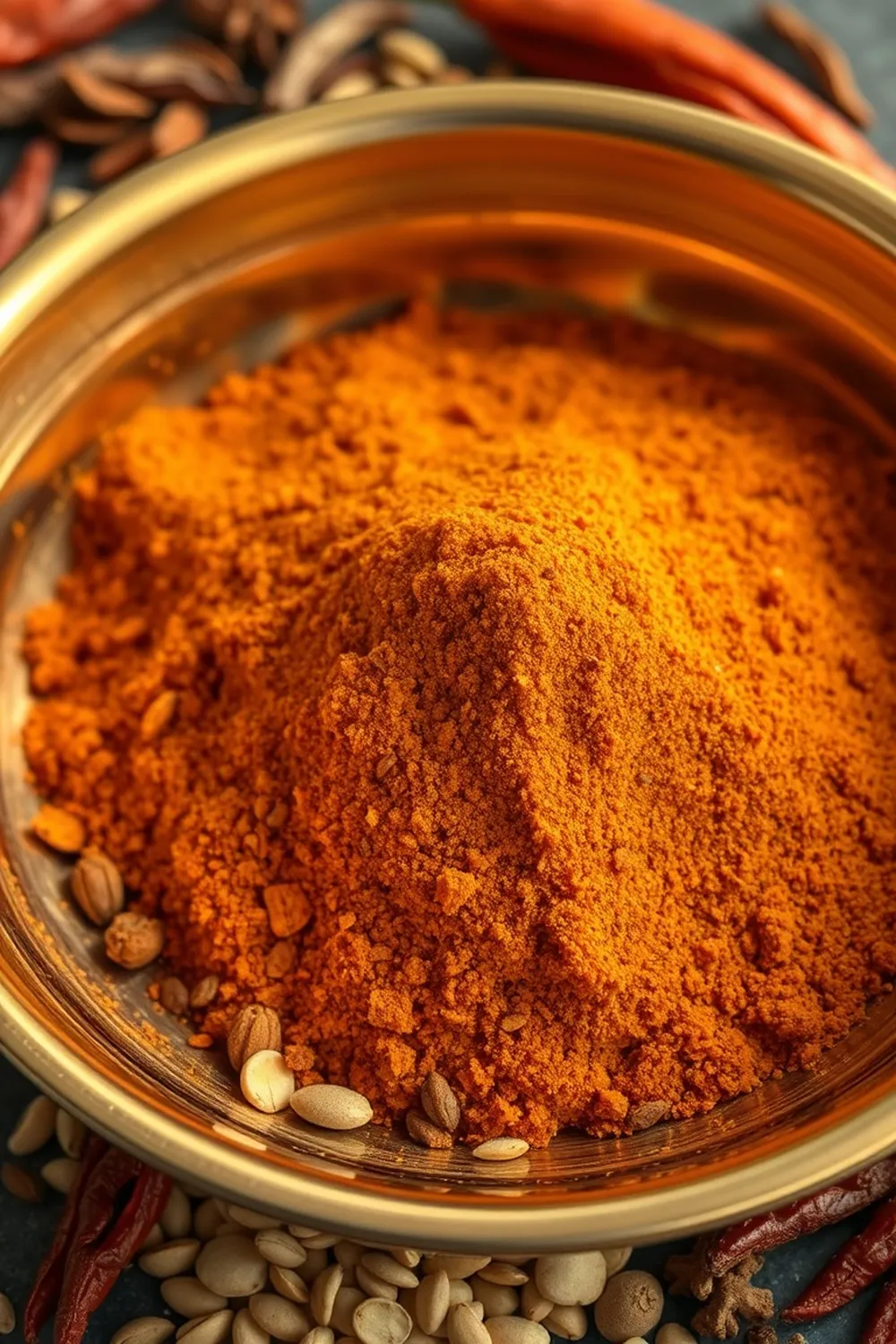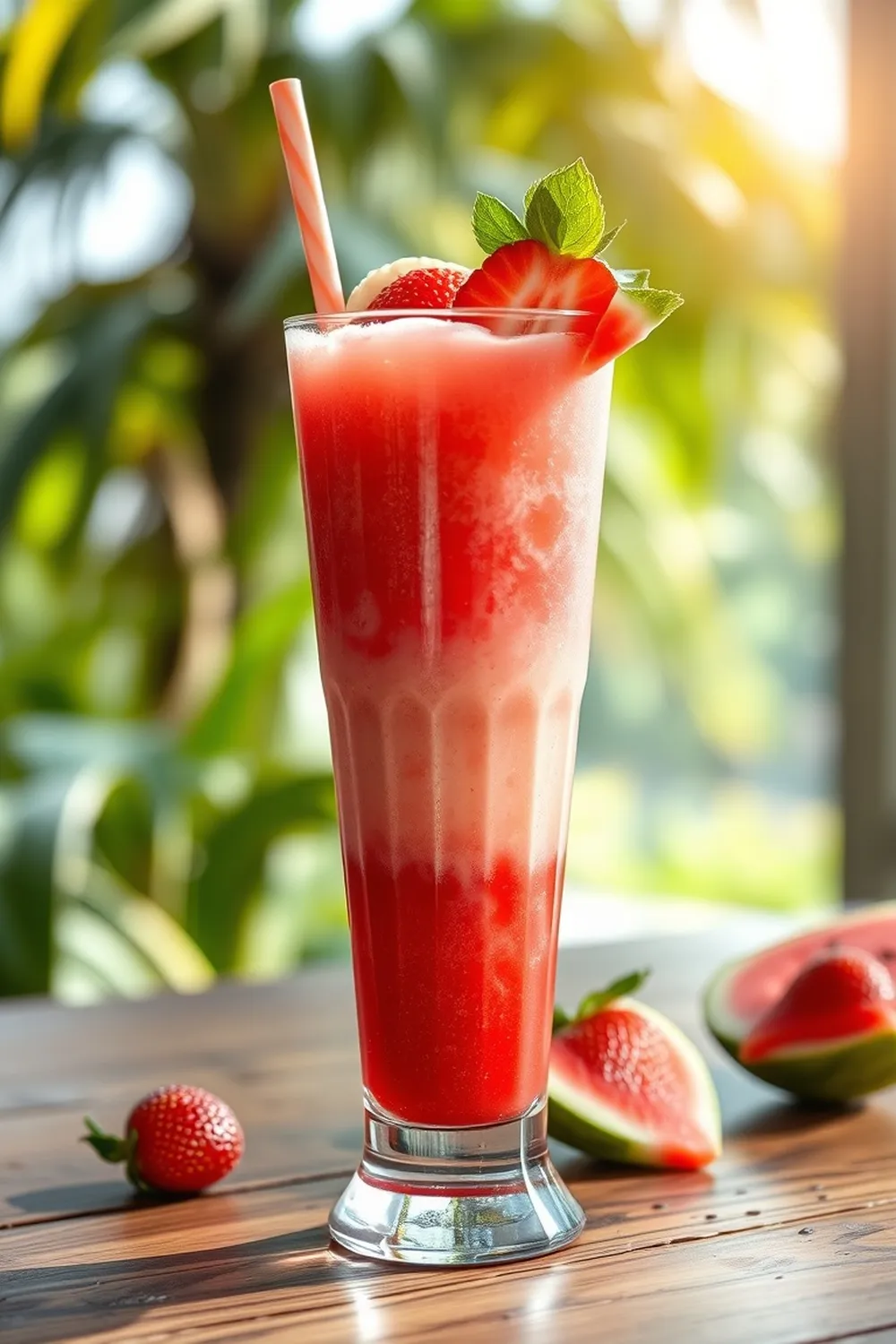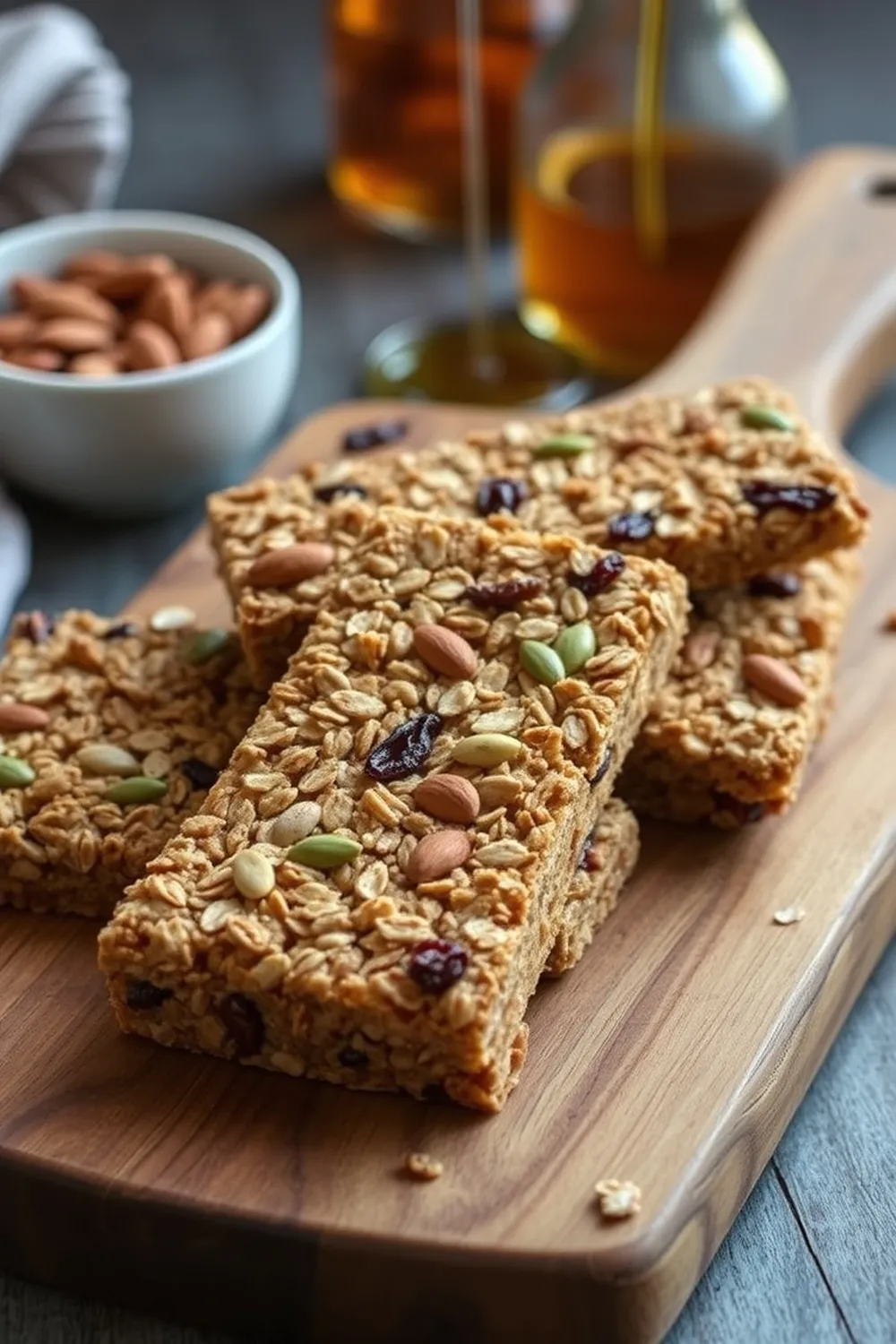- Heat oil in a pan and roast coriander seeds until fragrant. Transfer to a plate.
- Roast cumin seeds, caraway seeds, nigella seeds, sesame seeds, desiccated coconut, dry coconut, stone flower, and saffron separately, ensuring even roasting without burning.
- Roast cinnamon sticks, cloves, black peppercorns, cardamom pods, star anise, and Kashmiri red chilies until aromatic.
- Allow all roasted spices to cool completely.
- Grind the spices with nutmeg powder into a fine powder using a spice grinder.
- Store in an airtight container away from light and moisture.
- Calories:210 kcal25%
- Energy:878 kJ22%
- Protein:6 g28%
- Carbohydrates:25 mg40%
- Sugar:5 mg8%
- Salt:10 g25%
- Fat:12 g20%
Last Updated on 6 months ago by Neha Deshmukh
Authentic Indian Spice Powder Recipe – Coriander, Cumin & Kashmiri Chili
Hey everyone! If you’ve ever wondered what makes Indian food so flavorful, a huge part of the secret lies in the spice blends. Today, I’m sharing my go-to recipe for a homemade Indian spice powder – a fragrant mix of coriander, cumin, and Kashmiri chili that will elevate your cooking to a whole new level. I first made this when I was trying to recreate my grandmother’s incredible curries, and honestly, it made all the difference!
Why You’ll Love This Recipe
This isn’t just any spice powder. It’s a carefully balanced blend that adds warmth, depth, and a beautiful color to your dishes. Making your own spice powder allows you to control the quality and freshness of the ingredients, and honestly, the aroma while roasting the spices is just heavenly. Plus, it’s surprisingly easy to make!
Ingredients
Here’s what you’ll need to create this magic:
- 8 tablespoons coriander seeds (approximately 40 grams)
- 2 tablespoons cumin seeds (approximately 20 grams)
- 2 teaspoons caraway seeds (approximately 8 grams)
- 3 teaspoons niger seeds (karale) (approximately 9 grams)
- 7 tablespoons sesame seeds (approximately 35 grams)
- 6 tablespoons desiccated coconut (approximately 30 grams)
- 1 cup dry coconut (copra) (approximately 150 grams)
- 1 teaspoon stone flower (dagad phool) (approximately 3 grams)
- 1 teaspoon cobra’s saffron (nagkesar) (approximately 3 grams)
- 1 cinnamon stick (1 inch)
- 3 cloves
- 8 black peppercorns
- 1 black cardamom
- 2 green cardamoms
- 1 star anise
- 1 teaspoon nutmeg powder
- 0.25 cup dry Kashmiri red chilies (approximately 30 grams)
- 1 teaspoon neutral flavored oil
Ingredient Notes
Let’s talk about some of these ingredients – some might be new to you!
- Coriander Seeds: Sourcing & Freshness – Look for coriander seeds that are plump and have a strong aroma. Older seeds lose their flavor, so freshness is key. I usually buy mine from Indian grocery stores for the best quality.
- Cumin Seeds: Black vs. Green Varieties – You’ll typically find green cumin seeds, but black cumin seeds (shahi jeera) have a smokier flavor. Feel free to use a mix if you can find them!
- Caraway Seeds: Regional Usage in India – Caraway seeds aren’t used in every Indian dish, but they’re common in certain regional cuisines, particularly in North Indian spice blends. They add a slightly peppery, anise-like note.
- Niger Seeds (Karale): Unique Flavor Profile & Availability – These tiny black seeds have a slightly nutty and pungent flavor. They can sometimes be tricky to find, but most well-stocked Indian grocery stores will carry them.
- Stone Flower (Dagad Phool): Distinct Aroma & Medicinal Properties – This unique lichen adds an earthy, musky aroma to the spice blend. It’s often used in South Indian cuisine.
- Cobra’s Saffron (Nagkesar): Traditional Uses & Substitutes – Nagkesar has a delicate floral aroma and is used in traditional Ayurvedic medicine. If you can’t find it, you can omit it – it won’t drastically change the flavor, but it does add a special touch.
- Kashmiri Red Chilies: Color & Mild Heat – These chilies are prized for their vibrant red color and mild heat. They add a beautiful hue to your dishes without making them overly spicy.
- Dry Coconut (Copra): Difference from Desiccated Coconut – Dry coconut, or copra, is the dried kernel of the coconut. It has a more intense coconut flavor than desiccated coconut. If you can’t find copra, you can use more desiccated coconut, but the flavor won’t be quite as rich.
Step-By-Step Instructions
Alright, let’s get cooking!
- Roast the Coriander: Heat the oil in a pan over medium heat. Add the coriander seeds and roast for a few minutes, stirring constantly, until fragrant. This usually takes about 3-5 minutes. Transfer them to a plate to cool.
- Roast the Remaining Seeds: Now, roast the cumin seeds, caraway seeds, niger seeds, and sesame seeds separately. Keep a close eye on them – they burn easily! You want them lightly golden and fragrant. Set each aside to cool.
- Roast the Coconut: Roast the desiccated coconut and dry coconut (copra) until lightly golden. Again, watch carefully to prevent burning.
- Roast the Whole Spices: In the same pan, roast the cinnamon stick, cloves, black peppercorns, black cardamom, green cardamoms, star anise, and Kashmiri red chilies until aromatic. This should take about 2-3 minutes.
- Cool Completely: This is crucial. You need to let all the roasted spices cool completely before grinding. This prevents the heat from releasing too much oil and clumping the powder.
- Grind the Spices: Once cooled, grind all the spices together with the nutmeg powder in a spice grinder until you have a fine powder. You might need to do this in batches depending on the size of your grinder.
Expert Tips
- Don’t overcrowd the pan: Roast the spices in batches to ensure even roasting.
- Low and slow is key: Roasting over medium heat prevents burning and brings out the best flavor.
- Cooling is essential: Seriously, don’t skip this step!
Variations
Want to customize this spice powder? Here are a few ideas:
- Spice Level Adjustment: Reduce the amount of Kashmiri red chilies for a milder flavor, or add a pinch of cayenne pepper for extra heat.
- Vegan Adaptation (Naturally Vegan): This recipe is naturally vegan!
- Gluten-Free Adaptation (Naturally Gluten-Free): This recipe is naturally gluten-free!
- Regional Variations: For a South Indian twist, add a pinch of turmeric powder and a few curry leaves while roasting. For a North Indian blend, increase the amount of caraway seeds.
- Festival Adaptations: This spice powder is perfect for making special dishes during festivals like Diwali or Eid. My family loves using it in biryani and curries during celebrations.
Serving Suggestions
This spice powder is incredibly versatile! Use it to:
- Season curries and stews
- Marinate meats and vegetables
- Sprinkle over roasted vegetables
- Add to lentil dishes (dal)
- Make flavorful rice dishes
Storage Instructions
Store the spice powder in an airtight container away from light and moisture. It will stay fresh for up to 6 months.
FAQs
- What is the shelf life of homemade spice powder? Around 6 months if stored properly in an airtight container.
- Can I adjust the amount of Kashmiri red chili for more heat? Absolutely! Add a pinch of cayenne pepper or a few more Kashmiri chilies.
- What is the purpose of roasting the spices? Roasting enhances the flavor and aroma of the spices. It also helps to remove moisture, which extends their shelf life.
- What can I substitute for Stone Flower (Dagad Phool) if I can’t find it? You can omit it, or try a pinch of dried mushroom powder for a similar earthy note.
- Can I grind the spices in a mortar and pestle instead of a spice grinder? Yes, but it will take a lot more effort! A spice grinder is definitely recommended for a fine powder.
- How do I know if my spice powder has gone bad? If it has lost its aroma or flavor, it’s time to make a fresh batch.
- What is Cobra’s Saffron (Nagkesar) and is it essential to the recipe? It’s a traditional ingredient with a delicate floral aroma, but you can omit it if you can’t find it without significantly altering the flavor.
Enjoy! I hope this spice powder brings as much flavor and joy to your kitchen as it does to mine. Let me know in the comments how you use it!










